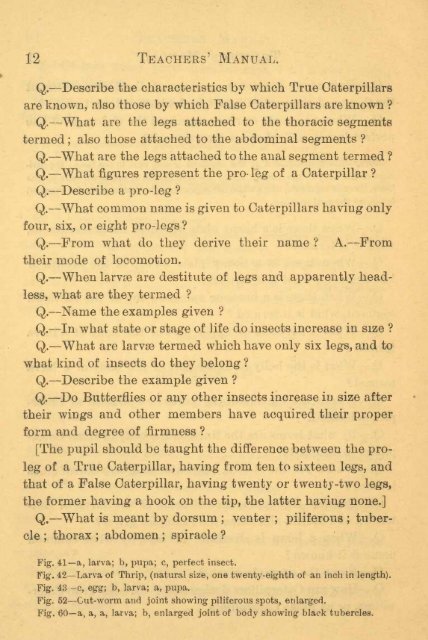Download - Free EBooks Library
Download - Free EBooks Library
Download - Free EBooks Library
You also want an ePaper? Increase the reach of your titles
YUMPU automatically turns print PDFs into web optimized ePapers that Google loves.
12 TEACHERS' MANUAL.<br />
Q.—Describe the characteristics by which True Caterpillars<br />
are known, also those by which False Caterpillars are known ?<br />
Q.—What are the legs attached to the thoracic segments<br />
termed; also those attached to the abdominal segments ?<br />
Q.—What are the legs attached to the anal segment termed ?<br />
Q.—What figures represent the pro leg of a Caterpillar ?<br />
Q.—Describe a pro-leg ?<br />
Q.—What common name is given to Caterpillars having only<br />
four, six, or eight pro-legs ?<br />
Q.—From what do they derive their name ? A.—From<br />
their mode of locomotion.<br />
Q.—When larvae are destitute of legs and apparently headless,<br />
what are they termed ?<br />
Q.—Name the examples given ?<br />
Q.—In what state or stage of life do insects increase in size ?<br />
Q.—What are larvae termed which have only six legs, and to<br />
what kind of insects do they belong ?<br />
Q.—Describe the example given ?<br />
Q.—Do Butterflies or any other insects increase in size after<br />
their wings and other members have acquired their proper<br />
form and degree of firmness ?<br />
[The pupil should be taught the difference between the proleg<br />
of a True Caterpillar, having from ten to sixteen legs, and<br />
that of a False Caterpillar, having twenty or twenty-two legs,<br />
the former having a hook on the tip, the latter having none.]<br />
Q.—What is meant by dorsum ; venter ; piliferous ; tubercle<br />
; thorax ; abdomen ; spiracle ?<br />
Fig. 41—a, larva; b, pupa; c, perfect insect.<br />
Fig. 42—Larva of Thrip, (natural size, one twenty-eighth of an inch in length).<br />
Fig. 43—e, egg; b, larva; a, pupa.<br />
Fig. 52—Cut-worm and joint showing piliferous spots, enlarged.<br />
Fig. 60—a, a, a, larva; b, enlarged joint of body showing black tubercles.








